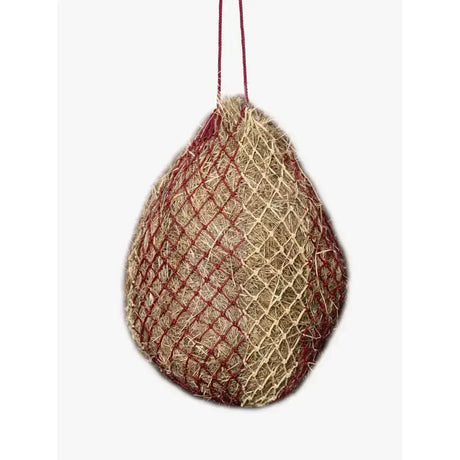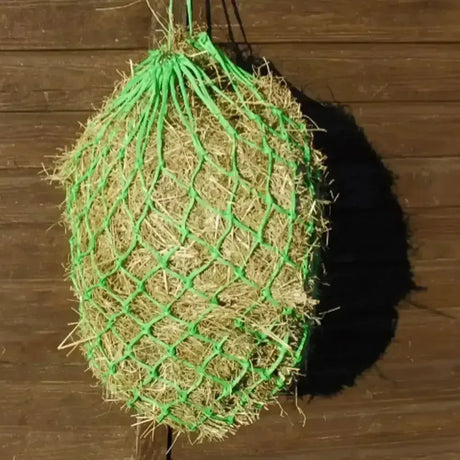Haynets
Haynets are a common tool used in equine management to hold and dispense hay for horses and other grazing animals. They come in various sizes, designs, and materials, each serving different purposes depending on the feeding needs of the horse. Here's a detailed overview of haynets:
Purpose of Haynets:
-
Controlled Feeding: Haynets are primarily used to regulate the amount of hay a horse consumes over time, helping to mimic the natural grazing behavior of horses by extending the time it takes for them to eat.
-
Reducing Waste: By keeping hay contained, haynets help to minimize the amount of hay that gets trampled, soiled, or blown away, leading to less waste.
-
Cleanliness: Haynets keep hay off the ground, reducing contamination by dirt, mud, or manure, which can help maintain better hygiene in the feeding area.
Types of Haynets:
-
Standard Haynets:
-
Design: These have medium-sized mesh holes (usually around 2-4 inches in diameter) and can hold a moderate to large amount of hay. They are suitable for most feeding situations.
-
Usage: Commonly used in stables, trailers, and paddocks. They provide a good balance between feeding time and accessibility.
-
Small-Mesh or Slow Feeder Haynets:
-
Design: These haynets feature smaller mesh holes, typically 1-2 inches in diameter, designed to slow down the horse's eating rate. The smaller holes make it harder for the horse to pull out large amounts of hay at once.
-
Usage: Ideal for horses that eat too quickly or need to be on a restricted diet. They help extend feeding time, promoting better digestion and reducing boredom.
-
Large Capacity Haynets:
-
Design: These haynets are larger and designed to hold more hay, making them suitable for longer feeding periods or when feeding multiple horses.
-
Usage: Often used in situations where frequent refilling is impractical, such as during overnight stabling or when multiple horses are fed from a single haynet.
-
Small Capacity Haynets:
-
Design: These are compact haynets designed to hold smaller amounts of hay, making them suitable for short feeding periods or for horses on a restricted diet.
-
Usage: Often used during travel, at competitions, or for horses that require portion control.
Materials Used in Haynets:
-
Nylon or Polyester: Most haynets are made from durable nylon or polyester, which are strong enough to withstand the constant pulling and tugging from horses. These materials are also resistant to weather and wear.
-
Cotton: Some haynets are made from softer cotton, which is gentler on the horse's mouth but may not be as durable as synthetic materials.
Advantages of Using Haynets:
-
Extended Feeding Time: Slower consumption rates promote better digestion and mimic natural grazing behaviors.
-
Reduced Hay Wastage: Keeping hay contained minimizes the amount that is wasted, saving money and keeping the feeding area cleaner.
-
Improved Hygiene: By keeping hay off the ground, haynets help reduce the risk of hay contamination, which can lead to better health for the horse.
Considerations When Using Haynets:
-
Safety: It’s important to hang haynets at a safe height to prevent horses from getting their hooves caught. Regularly inspect haynets for signs of wear and tear to avoid accidents.
-
Hanging Method: Ensure the haynet is securely tied and placed at a height that allows the horse to eat comfortably without straining its neck or risking injury.
-
Monitoring: Especially with slow-feeder haynets, monitor the horse’s intake to ensure they are still receiving enough forage throughout the day.
Common Situations for Using Haynets:
-
In Stables: To provide a controlled amount of hay during the horse’s time in the stall.
-
During Transport: To keep the horse occupied and reduce stress during travel.
-
In Paddocks or Fields: To prevent hay from being wasted on the ground when feeding outdoors.
Haynets are an essential tool for equine care, offering a practical way to manage feeding while promoting healthier eating habits and reducing waste.
























